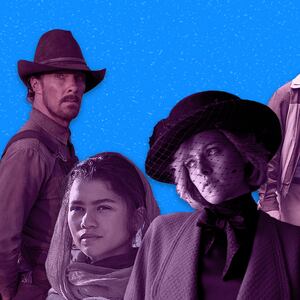A great delight of the Christmas season is being scared shitless in a cozy way, especially when it’s unexpected. Halloween gets the scary street cred, but Christmas is the real season of potential spookiness. The days are absurdly short, as if night has overpowered light. We reflect on the past—those we’ve known, loved, lost, in this emotional mishmash of cosmic and temporal planes. We’re often raw, vulnerable, and, let’s be honest, in our cups; in other words, we’re easy pickings for the things that give us the creeps.
I’ve always dug that some of the scariest works of art and entertainment were directed at children. Not because I want children to be traumatized; rather, I think they have a capacity for wonder that adults often don’t, and it can be as though the child is in on the haunting, which makes for an enjoyable form of possession.
There’s no better example in the Christmas-cartoon canon than a rendering of Charles Dickens’ A Christmas Carol that first aired fifty years ago, in 1971. I don’t know many people familiar with it—even Carol buffs, or lovers of the 1951 live-action version of the novella called Scrooge. The latter is a straight-up horror film, and one ripe for our age with its themes of depression, self-medication, disconnection, and lies about living one’s so-called “best life.”
ADVERTISEMENT
I have a vested interest in that film, because I just had a book come out about it, and all of its assorted frights. I mention the feature here because it starred Alastair Sim in the definitive turn as the miser, and the gifted character actor Michael Hordern as a Jacob Marley who will scare the pants off of you—or cause you to wet them, in the style of one of those eerily-authentic baby dolls.
Scrooge is part German Expressionism in the mold of Nosferatu and The Cabinet of Dr. Caligari, with aspects of the classic Universal horror cycle of Dracula, Frankenstein, and The Mummy. Jump in at any time, and you’d hardly know it’s a Christmas film at all. Mince pies, merrymaking and towering trees of glittering garland have been replaced by shadowy sets and a bleak midwinter of the soul.
I’d stumbled upon the movie by accident as a small child. But it wasn’t for several years that I had any inkling that Sim and Hordern reprised their roles in what has to be the most twisted holiday cartoon ever made—if we’re talking a program intended for children.
The half-hour animated film was directed by Richard Williams, a virtuoso of the form who later served as animation director on Who Framed Roger Rabbit. We begin at what appears to be a stenciled Big Ben springing to life as if it resides inside a Joseph Cornell box, traveling down the face of the clock, the structure, the roofs of the skyline, the buildings of London, with the curious effect of also seeming to travel upward. You’ll never see so much camera movement as you do in this animated work. It pulls to a stop at Scrooge’s counting house, and through the window we see Bob Cratchit scratching away at his figures, nephew Fred turning up to annoy his uncle, and those two charity collectors who are discarded like yesterday’s trash.
Noses are a big thing here—big as in long, lending a somewhat devilish aspect to everyone’s visage, even the good people like Cratchit. Scrooge eventually heads home for the night and it is when he gets inside of his house—which is more like a multi-tiered mausoleum—that I lost it as a kid. The screen shifts to near-blackness once Scrooge has gained ingress, his face a cadaverous orb that advances not just up the stairs to the bedroom, but toward us, as though the screen is three-dimensional. He thinks he’s encountered Marley’s contorted face in the door knocker outside, and now on the stairs, a pattering of noise becomes a coffin that flies up the stairs in pursuit.
I remember thinking this was so weird; and later, when I was older, so druggy, and yet sharp and clear-eyed. Maybe death is that way. You’re leaving this world, with a foot already in the next, and all is cloudy, but you still know.
The scene when the ghost of Marley shows up in 1951’s Scrooge is a virtuoso horror sequence, up there with the creation in Frankenstein (1931). Whereas Marley uncorks a howl of the damned in Scrooge when the penny-pincher expresses doubt as to his authenticity, there’s a different effect in the animated special: Marley removes a bandage from his head and his jaw falls the floor. As if this wasn’t bad enough, he then sticks his finger straight in Scrooge’s face and continues to talk without moving his mouth, words emitting from a black hole of hell.
How this was thought reasonable for kids, I have no clue. Marley’s ponderous fetters stretch across the whole of the floor like a phallic, post-Edenic snake (the damnation version). The effect is like Christmas horror porn—a verboten “treat” that a young person wouldn’t think was intended for their eyes.
The Ghost of Christmas Past—who is a female flame of light—arrives, whisks Scrooge away, and shares with him the most gutting experiences of his life until Scrooge, not able to endure anymore, attempts to kill the ghost by extinguishing her.
Sim doesn’t speak with the tart asperity that he does in the 1951 movie; his voice has more weariness. That impacts the mood, too, adding a layer of hoarfrost. The Ghost of Christmas Present is cloaked in a robe of green in stark opposition to the backgrounds of urban London which resemble, in their detailed cross-hatching, the sketches by Van Gogh that he’d make in the margins of letters.
The Ghost of Christmas Present opens his robe to Scrooge to reveal two near-naked children cowering at his feet—the boy being Ignorance, we are told; the girl Want—but they look like a cross between Gollum and monstrosities who managed to spring forth from one of Goya’s Black Paintings. As one would expect, the final haunting with the Ghost of Christmas Yet to Come doesn’t get rosier, the cemetery bit featuring gravestones arranged like the teeth of a vagina dentata. Ah, normal.
This was the animated Christmas film that broke all the rules, and it wasn’t finished with its content alone. ABC aired the program on December 21, and it became a hit of sorts—probably because it was just so damn different and had a hint of danger.
On the back of that success—or notoriety—A Christmas Carol was rushed into movie theaters (remember: this was an era when a holiday special only aired once a year, if that)—and it eventually won the Academy Award for Best Animated Short in 1972, which pissed some people off given that the short was released at a time when the small screen was held in low artistic regard. Thus, there was a change in the rules stipulating that a theatrical premiere had to come first for Oscar consideration.
The special then more or less disappeared. You could still catch the rare TV airing, and eventually bootleg copies came out—plus there’s always some charitable soul who uploads it to YouTube, perfect for screening after the others have gone to bed, and perhaps when you’re pondering your own mortality, too.
So, let a cartoon scare you shitless this Christmas, and have yourself a cozy nightmare. It’s the gift you didn’t know you needed.







